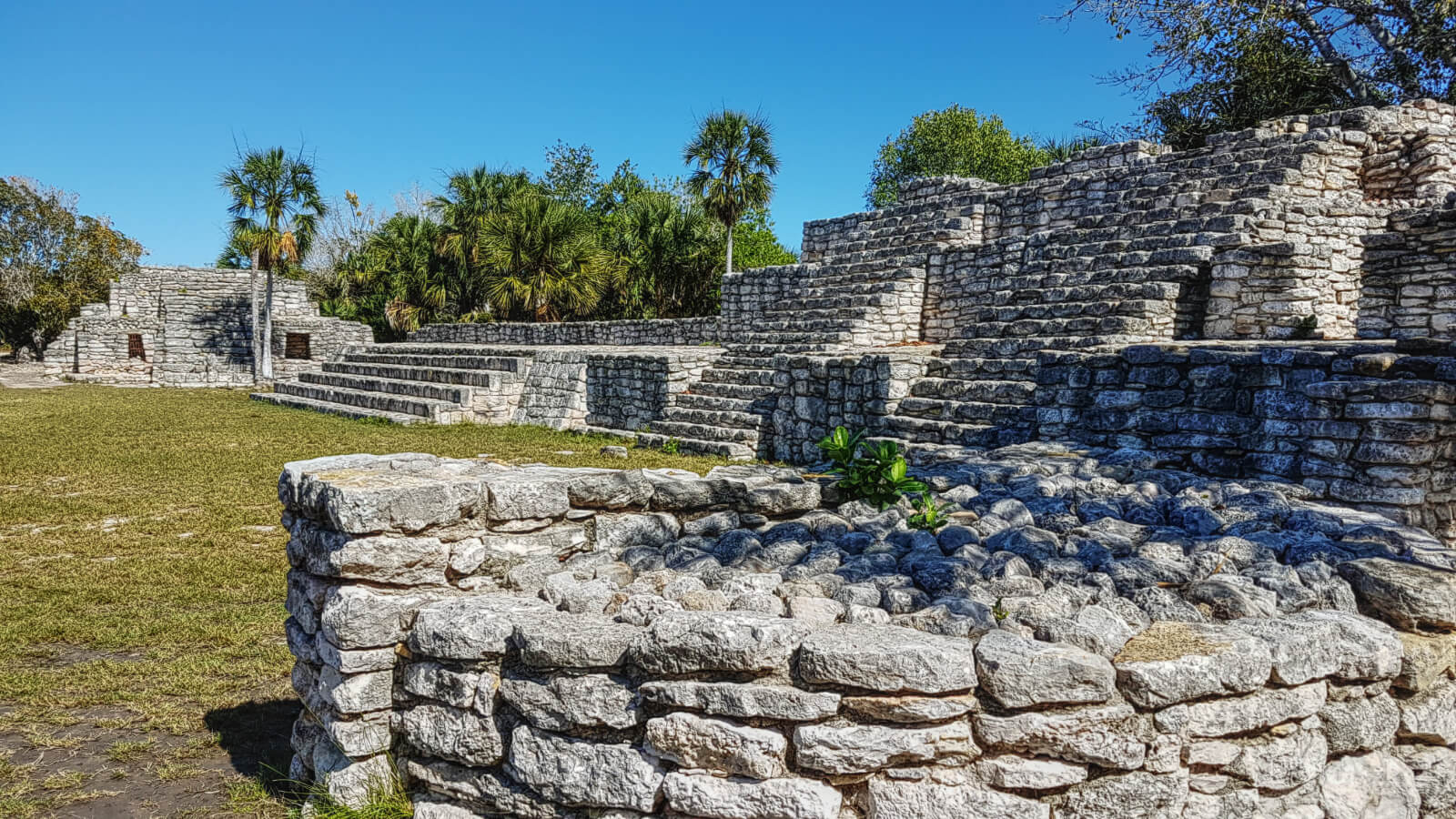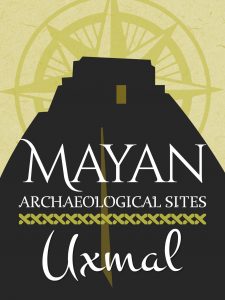
The most complete Guide to Xcambó

Xcambó
The Archaeological Site of Xcambó is located about 50 minutes from the City of Merida. This was an important trading city that specialized in salt production that was exported throughout the Mayan Peninsula.
The name of Xcambó comes from the Maya meaning Celestial Crocodile or Place where barter is carried out, for the history and the vestiges that have been found in this site, the most probable thing is that the real meaning is Place where barter is carried out.
In Xcambó there’s the main square where the largest buildings are located. In this Mayan archaeological site, just like in Dzibilchaltun, you’ll find a chapel that was built inside the site. This chapel or temple was built in the last century and was dedicated to the virgin that according to the Christian natives only appeared to the people who believed in her.
On both east and west of the main plaza, there are other plazas that were a residential area. Today you can see the vestiges in the form of foundations with low walls and platforms.
Interesting Facts
- Xcambó was the most important salt mine of the Mayan Peninsula.
- The name Xcambó comes from the Maya meaning Celestial Crocodile or Place where barter is done.
- This Mayan City was inhabited from 350 BCE until the Terminal Classic Period (830 - 950).
- It has dimensions of 700 m East-West and 150 m North-South.
Xcambó is open daily from 8 am to 4 pm.
Xcambó General Admission 2019
$75 MXN
Free admission for Mexican Citizens on Sundays.
Free admission every day for Mexican Citizens with the following valid IDs: Older than 60 years, retired, pensioned, teachers, students, children under 13 and handicapped.
Relax: You can walk around the residential area and the main plaza in less than an hour.
Tourist: If you want to see everything, stopping only to take pictures at ground level and on top of the pyramids, it may take around 1 hour.
Archeologist: If you already read about Xcambó’s history and its buildings, you might want to really explore the architecture and engravings around the monuments, the main plaza, both east and west plazas, and even stop on your way back to explore the other buildings.
This may take around 2 hours.
Recommendations
- Wear comfortable shoes You may wear sandals, but it’s best to take your hiking or tennis shoes. The pathways are a bit uneven unpaved, also you’ll have to keep an eye out for errant rocks and sticks.
- Protect yourself from harmful UV rays You may find some shades under the trees, but most of the time, you will be under direct sunlight, so make sure to use sunscreen, a hat, and it may also be a good idea to take an umbrella with you.
- Take what you may need like water, snacks and anything else because there's no stores near Xcambó.
- Visit the salt mines of Xtampú on your way to Xcambó, or on your way back.
- Bring cash.
Short Areal View of Xcambó
(1:08 minutes)

Learn about Xcambó and The Pyramid of the Masks The Temple of the Virgin The production of Salt the list goes on...
The coastal route uses the Mérida – Progreso highway (Mexico Highway 261 and YUC 27). From here you can see the emerald blue sea in some parts.
It’s 65 km from Mérida and you can get there in less than one hour.
The inland route uses the Motul highway (Mexico 176). From here you go in almost a straight line, but the time is practically the same.
It’s 60 km from Mérida and you can get there in approximately 50 minutes.
More about Xcambó
The relationship of Xcambó with other Mayan cities
In the Yucatan Peninsula, especially in the north, there seems to be homogeneity in both ceramic materials and architecture.
Xcambó was not the exception as there are walkways that connect it directly with two other sites:
Misnay, agricultural center 1280 m south, which was a supplier of labor and other resources that were scarce in Xcambó. It also played a role as a point of contact with the major interior sites.
Another of these roads seems to have communicated with the city of Dzemul, an important area that supported Xcambó, perhaps more important than Misnay. It was also an intermediary of other larger communities.
Xcambó Timeline
The Xcambó Timeline can give us an idea of the time it was inhabited and the influence it received by other Mayan cities.
Late Preclassic Period (350 BCE – 250)
On the northern coast of Yucatan and the rest of the peninsula, there were already numerous indications of settlements of various magnitudes and degrees of organization, but in general, they shared the same style in the construction of their public and housing buildings, but above all, use of the same ceramic groups was established.
Early Classic Period (250 – 550)
Xcambó was erected as a commercial port and its function consisted in the administration of salt and marine products, as well as being the center for the gathering of local, regional and supra-regional goods.
Middle Classic Period (550 – 830)
The archaeological site of Xcambó was standardized with the use of architecture based on rough rectangular blocks and flat slabs. It was necessary to apply a thick stucco plaster to hide the imperfections of the walls, which was done in a similar way in the post-classic period (1000 – 1450).
Late Classic Period (830 – 950) and Terminal (830 – 950)
During these periods the number of coastal sites increased, some of which were densely populated. Thus, in the central part of the northern coast, sites such as La Providencia and Xcambó emerge as major centers of salt production, where Xcambó must have been the most important.
Xcambó in the present time
This ancient Mayan city is still seen today as a place of pilgrimage and worship but not by any Mayan belief, but a Catholic one, the virgin of Xcambó.
According to tradition, the Chapel of the Virgin has been on the site for more than 50 years, it has been venerated ever since in this chapel on pre-Hispanic buildings.
Xcambo´s population and housing
To the east of the Main Square, both the layout of the buildings and their shapes are a little bit different. This sector was completely leveled with large basements so they could build the houses on them, but with walls and ceilings of perishable materials. The houses in this sector were more modest and were not as abundant as those on the opposite side. Probably the large spaces without constructions were used for outdoor work.
In both the East and West sectors, foundations were built on only one or two dwellings of nuclear families were built and possibly with fewer resources. These were separated with a sort of alleys to communicate with each other.
Xcambó and the salt
Xcambó was involved in the important economic role that was played in that strategic point of the peninsula, where the main interest was focused on the exploitation of salt.
It’s very obvious the importance of the salt economy on the northern coast of the Mayan Peninsula, which surely provoked a hard competition to get control of this city, being exploited continuously from before our common era to the present, although under the control of different major Mayan cities.
Xcambó Architecture
East Plaza

Towards the east of the Main Plaza, at a distance of 250 m, there are three public structures whose arrangement forms a small open plaza. These structures are not “inside” the main archaeological site. I would recommend you get there by car on your way back because it’s located a few meters away from the same road you used to get there.
West Plaza

To the west of the main plaza, there are other residences and areas of domestic activity where the rulers and other important people lived. These are foundations on which the masonry walls of the houses roofed with palms were built, located around small spaces in the form of lower patios or small contiguous quadrangles and generally joined by a common construction.

Pyramid of the Masks in Xcambó
The NE-23 Building, commonly known as the Pyramid of the Masks is the most recognized of the Xcambó Architecture, it presents at least three construction periods and several renovations. In its final phase, it was entirely covered by several stepped bodies made of rough blocks of different sizes, and only one stairway was built on the main façade made of megalithic blocks.
The large plastered and painted masks represented the Celestial Monster which is composed of the opposing pair Venus and the Sun. As the morning star Venus guides the Sun out of the Underworld, it travels next to it until the sunset. The concept of this journey and its direction is implied by the position of the masks in the temple; this same design is present in contemporary sites such as lzamal, Acanceh and Dzibilchaltún.
More about the Pyramid of the Masks.


The Temple of the Virgin of Xcambó
The Temple of the Virgin in Xcambó is obviously not part of the original Xcambó Architecture, but it’s now an important building among natives and visitors.
It was built in the middle of the last century on top of a Mayan construction. This is due to the tradition of the people of the town of Dzemul, name of the town where Xcambó is found, which says that since ancient times there has been a belief that among the ancient Mayan buildings lives a Virgin who only appears before those who have faith. For many of his devotees, she is the true owner of the archaeological zone.
More about the Temple of the Virgin.
















